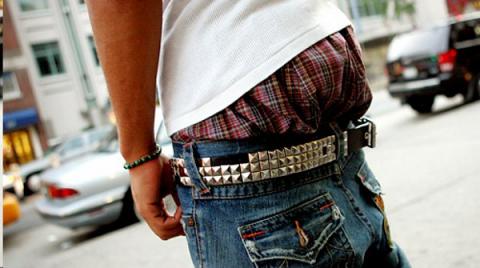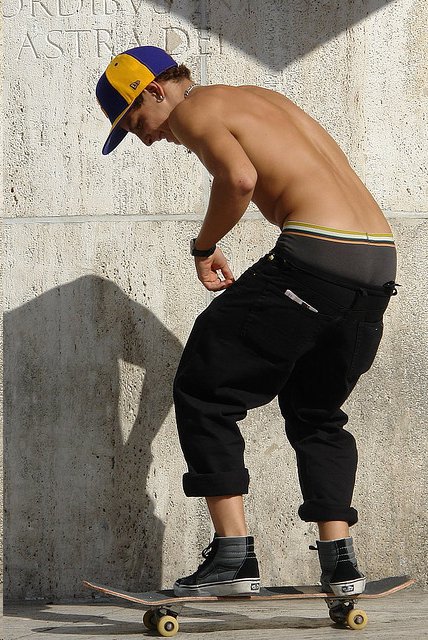Laws Devised to Ban ‘Saggers’ Potentially Violate First Amendment Rights

From New America Media and Louisiana Weekly:
Saggers are everywhere, from London to Paris, Barcelona to Port Au Prince, New Orleans to Steubenville, Ohio, and even Terrebonne Parish. Saggers are people, mostly young men who choose to wear their trousers particularly low on the hips, usually exposing about three to five inches of boxer shorts. While donning saggy pants isn’t exclusive to the United States, it is widely accepted that the “fashion” phenomenon was incubated in America’s prisons. But many local officials in cities across the U.S. don’t consider it fashion at all and have had enough of the trend that some call ridiculous and thuggish.
Others go further calling it indecent or even immoral. An official with the Black Mental Health Alliance of Massachusetts (BMHAM), a group that promotes parity in mental health services, thinks that wearing your jeans below your waist is a “behavioral health issue in our neighborhoods and communities that must be addressed.” And still others claim health reasons for banning saggy pants, citing potential future problems with hips and joints because of the “penguin” type walk saggers adopt in order to keep their pants up.
Fed up, cities from Cocoa Beach, Florida and Lynwood, Illinois to Boston, New York, Shreveport, and other communities around Louisiana are telling saggers to pull their pants up or face fines, community service and even prison time. The terms of the laws vary – some ban showing any underwear at all, some ban pants below the waist, some measure the number of inches that may show before violating the law. And the legal basis for the prohibitions aren’t clear, usually couched in terms of “obscenity” or “indecency,” although Louisiana law prohibits local communities from regulating obscenity more strictly than state law, which defines obscenity in terms of the exposure of specific body parts. Underwear isn’t included in that list. Regardless of the justification, the result is the same: law enforcement professionals, in effect, become “fashion police” when their duties include monitoring clothing styles. This seems an inefficient use of their time, not to mention the cost, both which could be better spent managing more serious and violent crime and issues of real public safety.
Saggy-Pants Laws Target Minorities
Saggy-pants laws violate a basic First Amendment right to free speech and the liberty interest in expression. Clothing style is one of the most personal forms of expression. An individual’s liberty interest is a basic right that falls under the same category as the other liberties guaranteed under the U.S. Constitution. Like stop and frisk and other so-called crime-fighting initiatives, saggy-pants laws invite trouble. Based on “a look,” police target certain communities, usually the African-American community, even though people of all races wear pants that might fall under the legal prohibitions. This racially based profiling leads to a disproportionate number of African Americans being stopped and searched unnecessarily, which in turn leads to unnecessary arrests for questionable minor offenses. The fact is that no link has been found between wearing saggy pants and increased crime or threat to public safety—but clothing has become a pretext to stop and search people for other things.
Many people, especially older, find the saggy pants trend objectionable, but does it qualify as a criminal act? It only becomes criminal when we make it so by passing laws that vilify what amounts to innocent behavior that in no way affects public safety. Benjamin Chavis, former executive director of the NAACP stated in a New York Times article, “I think to criminalize how a person wears their clothing is more offensive than what the remedy is trying to do.”

Waste of Public Resources at the Expense of Public Safety
There are those who argue that wearing saggy pants is modeled after prison behavior and that is reason enough to ban it. Others complain that it’s unsightly and impolite. Terrebonne Parish Council member Russell Hornsby said, “The problem is our young men are emulating prisoners. It sends a sign that you’re available for sex. It’s a bad example to set.”
But regardless of its genesis, the law is clear that people have the right to wear clothing that others may dislike – as long as prohibited portions of the anatomy remain covered. Criminalizing saggy pants, or any other fashion statement, sends the message that law enforcement must uphold a majoritarian view of aesthetics at the expense of public safety.
Consequently, law enforcement professionals devote time and resources monitoring fashion while many communities face serious public-safety issues and stretched budgets. Our police and courts would serve our communities better by focusing on violent individuals who pose a threat to their neighbors. We increase the risk to ourselves by using scarce resources targeting people who have done no harm other than to dress in a way that others don’t like.
This generational disconnect about clothing styles is nothing new. And even the most well-meaning adults haven’t always adhered to the same clothing styles. It’s tough to argue that sagging pants are inherently dangerous or violent; or that by itself, the height of a waistband puts others in the community at risk. In a state with the highest incarceration rate in the world, lawmakers would be well advised to consider the cost, both human and fiscal, of criminalizing harmless behavior at the public’s expense and the risk of public safety.
This article originally published in the July 8, 2013 print edition of The Louisiana Weekly newspaper.
Photos: New America Media; Charles Fred (Flickr).





























































































































































































































































































































